5 Most Interesting Auto Trends To Expect in 2025
Automotive innovations surge forward at a breathtaking pace. Consumer demand for cleaner energy, advanced safety, and engaging performance drives multiple paradigm shifts in vehicle development. Engineers pursue breakthroughs that reduce emissions without compromising driving pleasure.
Investors fund research that accelerates new technologies. Governments roll out incentives that entice manufacturers to release greener models. Cutting-edge solutions promise to redefine mobility by the year 2025.
Rise of Electric and Hybrid Vehicles
Electric and hybrid vehicles now lead the charge in transforming the automotive industry. Automakers introduce these models as central players in their lineups, no longer limiting them to niche markets.
Engineers develop advanced batteries that allow for longer ranges and significantly faster charging times. Charging stations appear in convenient locations like parking lots, highways, and residential areas, making recharging as simple as fueling up.
Governments drive adoption by offering tax incentives and rebates, giving more consumers the financial push to make the switch. As one of the most interesting auto trends to expect in 2025, the rise of these vehicles highlights a future where clean energy meets top-tier performance.
Stock Turbos Transforming Performance Expectations
Automakers install turbochargers as standard features on an expanding range of vehicles. Smaller engines equipped with turbos produce higher horsepower while burning less fuel, catering to drivers who demand spirited performance without massive engines.
Factory turbocharging was once primarily the purview of sports cars and tuner aficionados, but everyday sedans and crossovers now boast forced induction right off the assembly line. Stock vs. performance turbos are often a key consideration for drivers.
Stock systems deliver a reliable boost under warranty, while aftermarket performance turbos offer extreme power for enthusiasts. Aftermarket kits still attract modifiers seeking maximum gains, but modern stock turbos deliver satisfying driving dynamics for a wide range of vehicles.
Integration of Autonomous Driving Features
Engineers design advanced driver assistance systems (ADAS) that reduce human error and boost safety. Lane-centering technology corrects small steering deviations, while adaptive cruise control adjusts speeds to maintain optimal following distances.
Automated parking maneuvers cars into tight spots with minimal input from drivers. Sensor arrays analyze traffic patterns in real time to scan for potential hazards and react before collisions occur. Regulators collaborate with automakers to develop guidelines for partial and eventual full automation, recognizing potential reductions in accidents.
Expansion of Vehicle-to-Everything (V2X) Connectivity
Communication among vehicles, infrastructure, and smart devices reshapes mobility at both individual and city-wide levels. Cars relay speed, location, and hazard data to surrounding traffic, alerting others to accidents or construction zones. Seamless traffic light coordination reduces congestion, saving time and cutting emissions.
Engineers partner with telecommunications companies to harness high-speed 5G networks. Maps and infotainment systems update in real time, linking route guidance with weather forecasts and road conditions.
Rise of Sustainable Materials and Manufacturing
Automakers embrace sustainable materials and manufacturing processes that reduce waste and environmental impact. Factories now use recycled plastics, organic textiles, and biodegradable composites to create durable yet eco-friendly components.
Supply chains evolve with carbon-neutral shipping methods, lowering emissions tied to material transport. Inside vehicles, vegan leather and natural fibers replace traditional materials, offering modern, sustainable comfort without sacrificing style. Closed-loop manufacturing systems reclaim and reuse scraps, significantly cutting waste and production costs.
Among the most interesting auto trends to expect in 2025, sustainable innovation stands out as both a response to consumer demand and a testament to the industry’s commitment to environmental responsibility.

